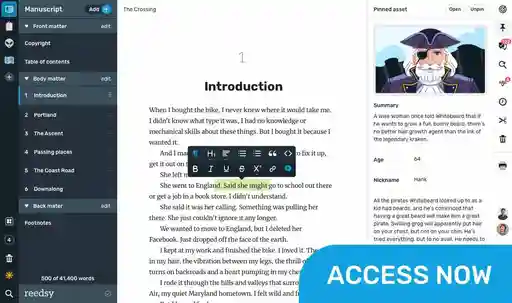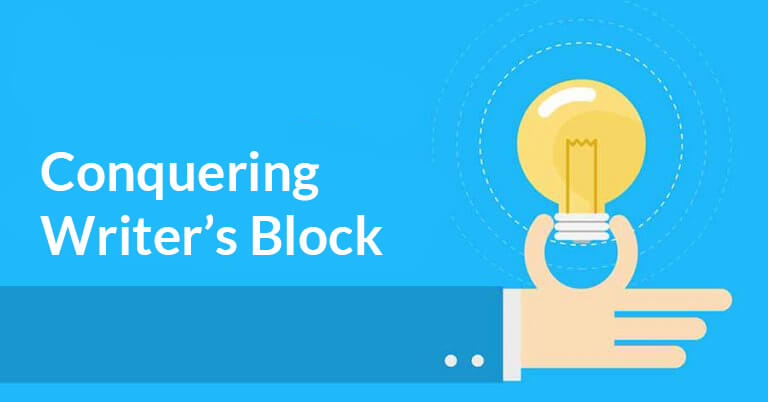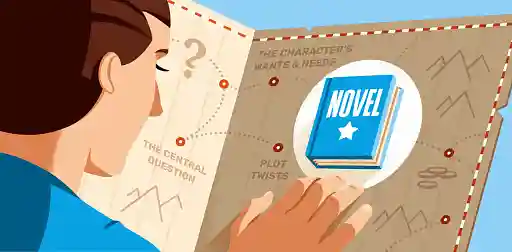Posted on Jul 13, 2018
20+ Writing Strategies (That Helped Bestselling Authors Finish Their Books)
So you've decided today that you want to write. Great!
Now how exactly are you going to do it?
Luckily, we have a precedent to which to turn. From idea generation to the art of editing, there are thousands of writing strategies out there to get you past the finish line — and we gathered the best ones in this post. Here are 20+ writing strategies that you can use to help you over the finish line.
1. Mary Lee Settle’s “Question” Writing Strategy
If you’re going through a drought of story ideas, you might want to run to an inspiration source that will never run out: questions.
In a talk with the New York Times, National Book Award-winner Mary Lee Settle explained:
“I start with a question. Then try to answer it.”
This writing strategy is endorsed by many other writers, most notably fantasy author Neil Gaiman. He wrote that a particularly magical question to ask yourself is, “What if _________?” For instance: “What if I wake up with wings?” Or, “What if your sister turned into a mouse?”
So your first plan of attack is to wonder about anything in the world: from the meaning to life to whether or not shrews could one day fall from the sky. As it turns out, no question is too silly — or weird — to give birth to a good story.
2. Ray Bradbury’s Library Scene
“When in doubt, go to the library,” as Hermione Granger might say. She’d be pleased to know that world-famous author Ray Bradbury is on her side:
“When I graduated from high school I couldn’t go to college, so I went to the library 3 days a week for 10 years.”
Bradbury ended up taking out 10 books every week — meaning that he read at least a hundred books a year. Coincidentally, this was William Faulkner’s writing strategy, as well: "Read, read, read. Read everything — trash, classics, good and bad, and see how they do it. Just like a carpenter who works as an apprentice and studies the master. Read!”
If you decide to follow their advice, you might turn the corner and come across an idea in the least surprising place of all: other books.
3. Orson Scott Card’s Mindfulness Approach
Sometimes writers get so stuck in their own minds that they can’t tell a great idea from a blob of words on the screen. If this sounds familiar, it’s probably time to go for a walk and smell the grass. According to Orson Scott Card, author of Ender’s Game:
“Everybody walks past a thousand story ideas every day. The good writers are the ones who see five or six of them. Most people don’t see any.”
Walking is a proven writing strategy that improves creativity and gives your ideas some legs. Agatha Christie’s plots, for instance, were often purely inspired by a stroll around the neighborhood. Her second book, The Secret Adversary, arose from a conversation she overheard in a coffee shop. “Two people were talking at a table nearby, discussing somebody called Jane Fish…” she wrote. “That, I thought, would make a good beginning to a story — a name overheard at a tea shop — an unusual name, so that whoever heard it remembered it.”
To check out ten of Agatha Christie's best ever mysteries, go to this post right here.
4. Robert Louis Stevenson’s Notebook Scheme
Once you latch onto an idea that you know in your bones is good, you need to seize it with all your might and not let go. There’s nothing worse than realizing that you’ve forgotten the great idea that occurred to you the previous night — all because you neglected to write it down.
To avoid this potential catastrophe, Robert Louis Stevenson, author of The Strange Case of Dr. Jekyll and Mr. Hyde, offered this writing strategy:
"I kept always two books in my pocket, one to read, one to write in."
For everyone living in the 21st-century: this probably means keeping the Notes app on your cellphone handy. But you won’t go wrong with an old-fashioned notebook, either — so long as it’s nearby whenever you come up with a story idea.
5. Mark Twain’s “Increment” Writing Strategy
Now that you're committed to writing a story, you may be intimidated by the blank sheet in front of you. All of a sudden, you can’t think anything else but the pages and pages of words that lie in your near future — oh, and is that a migraine coming on? Great.
For this particular brand of headache, Mark Twain proposed a cure:
“The secret of getting ahead is getting started. The secret of getting started is breaking your complex overwhelming tasks into small manageable tasks, and then starting on the first one.”
In short, make a molehill out of the mountain. You can tackle any 100,000-word monster if you just think of it in smaller parts: whether that’s by scene, chapter, arc, or a daily word count goal.
6. Norman Mailer’s Daily Routine Policy
It’s no secret that 50% of being an writer is, well, writing. The other 50% is complaining about writing. To counter the urge to procrastinate, we can draw on American novelist Norman Mailer’s wisdom here:
“Over the years, I’ve found one rule. It is the only one I give on those occasions when I talk about writing. A simple rule. If you tell yourself you are going to be at your desk tomorrow, you are by that declaration asking your unconscious to prepare the material. You are, in effect, contracting to pick up such valuables at a given time. Count on me, you are saying to a few forces below: I will be there to write.”
That said, there’s no proven “best time” to write. Benjamin Franklin supposedly sat down at his desk to write at 6 am. Then you have F. Scott Fitzgerald, who wouldn’t rise until just before midday to start his work. (You can check out the morning routines of more famous authors in this infographic here.)
Whenever you do decide to start your writing day, just make sure that the time you’ve set aside is sacred. As J.K. Rowling said, you must be absolutely ruthless about protecting writing days: “Do not cave in to endless requests to have "essential" and "long overdue" meetings on those days.”
7. Katherine Anne Porter’s “Last Line” Writing Strategy
According to Pulitzer Prize-winning Katherine Anne Porter, sometimes you might need to think upside-down in order to write right-side up:
“If I didn’t know the ending of a story, I wouldn’t begin. I always write my last line, my last paragraph, my last page first.”
Getting the ending down will give you something to write towards — and the confidence that a finish line is in sight.
8. Jane Yolen’s Work-Out Method
Unfortunately, writing isn’t magic. Once you’ve figured out a writing routine that works, you need to make sure you actually do the thing: write.
Many authors recommend writing at least once a day. There’s a good reason for it — and it isn’t masochism! Jane Yolen explains the reasoning here:
“Exercise the writing muscle every day, even if it is only a letter, notes, a title list, a character sketch, a journal entry. Writers are like dancers, like athletes. Without that exercise, the muscles seize up.”
9. Ernest Hemingway’s “Stop While You’re Ahead” Gambit
Maintaining momentum during a multi-month slog is one of the hardest parts of writing. But Nobel Laureate Ernest Hemingway offered this as a tried and true strategy:
“The best way is always to stop when you are going good and when you know what will happen next. If you do that every day … you will never be stuck. Always stop while you are going good and don’t think about it or worry about it until you start to write the next day. That way your subconscious will work on it all the time. But if you think about it consciously or worry about it you will kill it and your brain will be tired before you start.”
Many authors who use this “stop while you’re ahead” strategy will pause mid-scene or mid-paragraph. Some even go so far as to quit writing mid-sentence. One writer who has sworn by this advice is none other than Roald Dahl: “You make yourself stop and you walk away. And you can’t wait to get back because you know what you want to say next.”
You may have your eyebrow raised in doubt. How can you learn not to worry? Hemingway has an answer for you, too: “By not thinking about it. As soon as you start to think about it stop it. Think about something else. You have to learn that.”
10. Henry David Thoreau’s “Full Speed Ahead” Strategy
That said, we understand that it can be hard to stop writing when you’re in full-flow — much like reining in a horse when he’s racing at full stride. If Hemingway’s writing strategy doesn’t sit well with you, Henry David Thoreau has this alternative:
“Write while the heat is in you. The writer who postpones the recording of his thoughts uses an iron which has cooled to burn a hole with. He cannot inflame the minds of his audience.”
To put another slant to it, you can think about it in terms of Saul Bellow’s “Insomnia” Strategy. Bellow, the Pulitzer Prize winner, once wrote: “You never have to change anything you got up in the middle of the night to write.” Just to be clear, we’re not telling you that you have to set your alarm to 3am every night. But it’s good to remember that the urge to write can overcome you at any time of the day. If something is so significant that it compels you to wake up from your sleep, jot it down.
11. Roald Dahl’s Cocoon System
Has nothing inspired you to write yet? Maybe it's time for a change of location. Here’s how a friend of Roald Dahl’s explained the author’s odd writing strategy:
“He steps into a sleeping bag, pulls it up to his waist and settles himself in a faded wing-backed armchair. His feet he rests on a battered travelling case full of logs. This is roped to the legs of the armchair so it’s always at a perfect distance.”
Dahl wasn’t alone in finding strange places to write. Gertrude Stein wrote in the driver’s seat of her Model T Ford, which meant that she was especially prolific during shopping expeditions. Marcel Proust refused to work anywhere but his bed. But perhaps the writing situation of Edith Sitwell takes the proverbial cake. Despite her name, she found that she wrote best lying down… in an open coffin. A grave mistake for most people, but not her.
12. Raymond Chandler’s “Man with a Gun” Method
Last but not least, whenever you’re not sure where to take your story next, you can heed Raymond Chandler’s strategy for chapter-writing:
“When in doubt how to end a chapter, bring in a man with a gun.”
Now, this probably isn’t going to be the kind of advice that you’ll want to take literally — but it’s a reminder to keep the ante upped so that your story never becomes stale. In other words, end each chapter with a metaphorical bang.
13. Neil Gaiman’s “Don’t Look at It Again” Approach
Have you every written a story, thought it was the best thing since sliced bread, and came back to it the next day to revel in your masterpiece — only to gape in horror because it turned into a demon baby in the middle of the night?
Luckily, this happens to every writer. In fact, Neil Gaiman says that time spent away from your manuscript is a necessary part of the editing process:
“The best advice I can give on this is, once it’s done, to put it away until you can read it with new eyes. Finish the short story, print it out, then put it in a drawer and write other things. When you’re ready, pick it up and read it, as if you’ve never read it before. If there are things you aren’t satisfied with as a reader, go in and fix them as a writer: that’s revision.”
Putting your story aside for a few days or months gives you the chance to evaluate your story objectively and see its faults. Most importantly, it allows you to experience your story as a reader. Ultimately, “revision” is a combination of “re-“ and “vision”: the act of returning to something with new eyes.
14. Anton Chekhov’s Ending and Beginning Strategy
Aside from his world-famous Gun technique, Anton Chekhov had some more neat advice on editing:
My own experience is that once a story has been written, one has to cross out the beginning and the end. It is there that we authors do most of our lying.
Readers are ruthless creatures: if your book doesn’t sweep them up in the first twenty pages, chances are that they’ll put your book down entirely. We don't think Chekhov meant you have to cut the entire beginning and end out — just that it’s worth re-visiting those parts of the story first when you’re tightening your narrative.
15. Stephen King’s “Road to Hell” Plan
Whether or not you’re religious, you’ll want to keep Stephen King’s advice in mind:
“I believe the road to hell is paved with adverbs, and I will shout it from the rooftops.”
Be cautious about using too many adverbs: their mere existence might mean that you’re telling, not showing, says King.
“To put it another way, they’re like dandelions. If you have one in your lawn, it looks pretty and unique. If you fail to root it out, however, you find five the next day… fifty the day after that… and then, my brothers and sisters, your lawn is totally, completely, and profligately covered with dandelions. By then you see them for the weeds they really are, but by then it’s — GASP!! — too late.”
16. Mark Twain’s “Damn” Proposition
If you’re ever agonizing over whether or not you should take something out, Mark Twain has a very simple strategy for you:
“Substitute ‘damn’ every time you’re inclined to write ‘very’; your editor will delete it and the writing will be just as it should be.”
To follow Twain's advice, delete any “filler” word unless it’s absolutely essential. This includes words like “very” and also “really,” “things,” and “stuff.” Quartz recommends substituting a more concise word for “very” — for instance, “terrified” instead of “very afraid.” You can see this post for some more helpful options.
17. Walt Whitman’s Comma Technique
Let us be crystal clear: there’s nothing that will get a reader or an agent to drop your manuscript quicker than a bunch of punctuation errors in a row. Walt Whitman boils it down into a very simple statement:
“I hate commas in the wrong places.”
Even after you’ve given your draft an edit to identify structural and flow issues, you’ll need to proofread it with a discerning eye. Identify speling erors, spots where commas are missing or overused, and places where someone says “Hello” without proper punctuation. Trust us — your readers will thank you for it.
18. Maya Angelou’s “Write Anything” Mode
Seriously, anything. You can take Maya Angelou’s award-winning words for it:
“What I try to do is write. I may write for two weeks, ‘The cat sat on the mat, that is that, not a rat.’ And it might be just the most boring and awful stuff. But I try. When I’m writing, I write. And then it’s as if the muse is convinced that I’m serious and says, ‘Okay. Okay. I’ll come.’”
“The cat sat on the mat, that is that, not a rat,” doesn’t exactly sound very glamorous, does it? But Maya Angelou also wrote I Know Why The Caged Bird Sings and was nominated for a Pulitzer Prize in 1971, so she knows a thing or two about writing.
19. George Plimpton’s Letter Strategy
If the thought of an agent or thousands of people reading your story makes you sweat, you might have the literary version of "stage fright." To help curb this type of writer's block, the Paris Review founder George Plimpton used to follow this strategy:
“Many years ago, I met John Steinbeck at a party in Sag Harbor, and told him that I had writer’s block. And he said something which I’ve always remembered, and which works. He said, “Pretend that you’re writing not to your editor or to an audience or to a readership, but to someone close, like your sister, or your mother, or someone that you like.” And at the time I was enamored of Jean Seberg, the actress, and I had to write an article about taking Marianne Moore to a baseball game, and I started it off, “Dear Jean . . . ,” and wrote this piece with some ease, I must say. And to my astonishment that’s the way it appeared in Harper’s Magazine. “Dear Jean . . .” Which surprised her, I think, and me, and very likely Marianne Moore.”
We’ll let Steinbeck, the person who first came up with this ingenious writing strategy, explain the reasoning behind it: “Write it as a letter aimed at one person. This removes the vague terror of addressing the large and faceless audience and it also, you will find, will give a sense of freedom and a lack of self-consciousness.”
Plimpton wasn’t kidding, by the way: you can read his October 1964 article in Harper’s Magazine here.
20. Hilary Mantel’s “Do Anything” Technique
What if you’re just sick of words altogether? For a change of pace, let’s try something that doesn’t involve writing — in any capacity. Hilary Mantel says that sometimes what you need to do in order to write is not write:
“If you get stuck, get away from your desk. Take a walk, take a bath, go to sleep, make a pie, draw, listen to music, meditate, exercise; whatever you do, don’t just stick there scowling at the problem. But don’t make telephone calls or go to a party; if you do, other people’s words will pour in where your lost words should be. Open a gap for them, create a space. Be patient.”
Force yourself to disengage from your manuscript and you might come back sharper and more aware of what you want to say. Jane Smiley, for instance, would drink Diet Cokes to distract herself, explaining: “When you sit down again on Saturday, you’re better. Not only because of all the practice, but also because of the walking away. I’m a firm believer in walking away.”
21. P.G. Wodehouse’s Cursing Approach
If you’ve come this far and all else has failed, know that you can always resort to P.G. Wodehouse’s tried, true, and completely professional advice:
“I just sit at my typewriter and curse a bit.”
Do you have any more writing strategies to share? How about writer's block memes? Have you found any strategy useful so far? Tell us in the comments below!













1 response
Glen Barrington says:
23/10/2018 – 14:16
Hmmm! So the survey says! Nobody knows for sure!